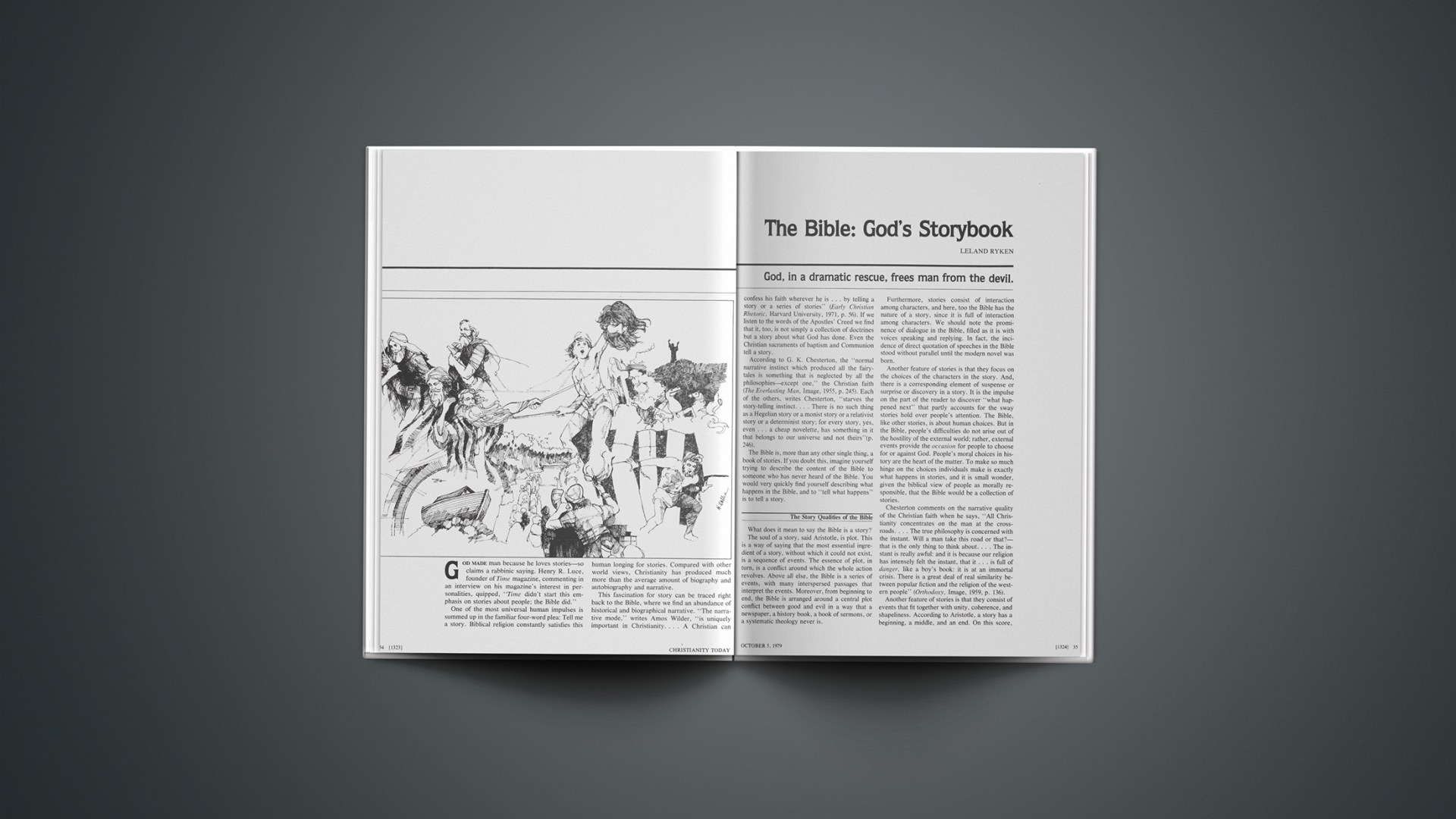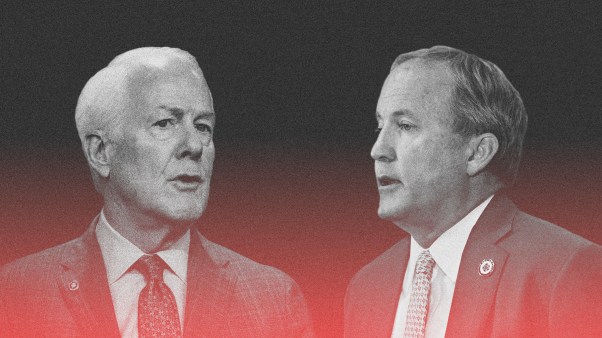A mystical romance come true.
God, in a dramatic rescue, frees man from the devil.
God made man because he loves stories—so claims a rabbinic saying. Henry R. Luce, founder of Time magazine, commenting in an interview on his magazine’s interest in personalities, quipped, “Time didn’t start this emphasis on stories about people; the Bible did.”
One of the most universal human impulses is summed up in the familiar four-word plea: Tell me a story. Biblical religion constantly satisfies this human longing for stories. Compared with other world views, Christianity has produced much more than the average amount of biography and autobiography and narrative.
This fascination for story can be traced right back to the Bible, where we find an abundance of historical and biographical narrative. “The narrative mode,” writes Amos Wilder, “is uniquely important in Christianity.… A Christian can confess his faith wherever he is … by telling a story or a series of stories” (Early Christian Rhetoric, Harvard University, 1971, p. 56). If we listen to the words of the Apostles’ Creed we find that it, too, is not simply a collection of doctrines but a story about what God has done. Even the Christian sacraments of baptism and Communion tell a story.
According to G. K. Chesterton, the “normal narrative instinct which produced all the fairy-tales is something that is neglected by all the philosophies—except one,” the Christian faith (The Everlasting Man, Image, 1955, p. 245). Each of the others, writes Chesterton, “starves the story-telling instinct.… There is no such thing as a Hegelian story or a monist story or a relativist story or a determinist story; for every story, yes, even … a cheap novelette, has something in it that belongs to our universe and not theirs” (p. 246).
The Bible is, more than any other single thing, a book of stories. If you doubt this, imagine yourself trying to describe the content of the Bible to someone who has never heard of the Bible. You would very quickly find yourself describing what happens in the Bible, and to “tell what happens” is to tell a story.
The Story Qualities Of The Bible
What does it mean to say the Bible is a story?
The soul of a story, said Aristotle, is plot. This is a way of saying that the most essential ingredient of a story, without which it could not exist, is a sequence of events. The essence of plot, in turn, is a conflict around which the whole action revolves. Above all else, the Bible is a series of events, with many interspersed passages that interpret the events. Moreover, from beginning to end, the Bible is arranged around a central plot conflict between good and evil in a way that a newspaper, a history book, a book of sermons, or a systematic theology never is.
Furthermore, stories consist of interaction among characters, and here, too the Bible has the nature of a story, since it is full of interaction among characters. We should note the prominence of dialogue in the Bible, filled as it is with voices speaking and replying. In fact, the incidence of direct quotation of speeches in the Bible stood without parallel until the modern novel was born.
Another feature of stories is that they focus on the choices of the characters in the story. And, there is a corresponding element of suspense or surprise or discovery in a story. It is the impulse on the part of the reader to discover “what happened next” that partly accounts for the sway stories hold over people’s attention. The Bible, like other stories, is about human choices. But in the Bible, people’s difficulties do not arise out of the hostility of the external world; rather, external events provide the occasion for people to choose for or against God. People’s moral choices in history are the heart of the matter. To make so much hinge on the choices individuals make is exactly what happens in stories, and it is small wonder, given the biblical view of people as morally responsible, that the Bible would be a collection of stories.
Chesterton comments on the narrative quality of the Christian faith when he says, “All Christianity concentrates on the man at the crossroads.… The true philosophy is concerned with the instant. Will a man take this road or that?—that is the only thing to think about.… The instant is really awful: and it is because our religion has intensely felt the instant, that it … is full of danger, like a boy’s book: it is at an immortal crisis. There is a great deal of real similarity between popular fiction and the religion of the western people” (Orthodoxy, Image, 1959, p. 136).
Another feature of stories is that they consist of events that fit together with unity, coherence, and shapeliness. According to Aristotle, a story has a beginning, a middle, and an end. On this score, too, the Bible makes up a story; its beginning is literally the beginning—God’s creation of the world and his placing of Adam and Eve in the garden; the middle is the universal history of the human race, controlled by a sovereign God; and its end is literally the end—the end of history, as portrayed in the book of the Revelation. We can contrast the simple garden populated by two people at the beginning of the story with the city at the end that contains a multitude no man can number.
By ending where it did not begin, the Bible follows a basic principle of stories. “All the other philosophies,” writes Chesterton, “avowedly end where they begin; and it is the definition of a story that it ends differently; that it begins in one place and ends in another. From Buddha and his wheel to … Pythagoras with his abstraction of number to Confucius with his religion of routine, there is not one of them that does not in some way sin against the soul of story” (The Everlasting Man, p. 245).
Stories are unified around a central protagonist, and so is the Bible. The characterization of God is the main concern of the Bible, and it is pursued from beginning to end. All other characters and events interact with this great Protagonist. The story of the Bible is the story of God’s acts in history, which biblical scholars have popularized in the terms “salvation history” or “holy history.” Salvation history is the story of how God entered history to save individuals and, in the Old Testament, a nation, from physical and spiritual destruction. Wilder comments, “God is an active and purposeful God and his action with and for me has a beginning, a middle and an end like any good story” (p. 56).
Stories, finally, are full of the concrete experience of everyday life. The storyteller is never content with abstract propositions: his impulse is to show, not merely to tell about an event. Stories appeal to us through our senses and emotions. A storyteller does not have a thesis to prove with arguments—he has a story to tell. Flannery O’Conner, the Catholic fiction writer, has said it all when she observes that a storyteller speaks “with character and action, not about character and action” (Mystery and Manners, Farrar, Straus & Giroux, 1957, p. 76). In stories, including those in the Bible, theological and moral meanings are incarnated in the story itself. This means that it is impossible to state the message of a biblical story without first interacting with the characters and events and settings in the story.
The Bible, then, should be regarded as a story because it consists of those very things that we associate with stories. These include plot conflict, interaction among characters, emphasis on human choice, a unified and coherent pattern of events that ends where it did not begin, a central protagonist, and the incarnation of meaning in concrete settings and characters and events. The narrative quality of the Bible is rooted in the character of God, for God is above all the God who acts.
The Bible: A Realistic Story
Anyone who simply starts to read the stories of the Bible will sense at once that they are full of facts and details, rooted firmly to the earth and to actual human experience as we know it. They are full of what is called realism.
For one thing, the writers of biblical stories are preoccupied with locating their stories in space-time history. Consider, for example, how the stories of the Bible typically begin:
“And Abram took Sarai his wife, and Lot his brother’s son, and all their possessions which they … had gotten in Haran; and they set forth to go to the land of Canaan. When they had come to the land of Canaan, Abram passed through the land to the place at Shechem, to the oak of Moreh. At that time the Canaanites were in the land” (Gen. 12:5–6).
“In the days when the judges ruled there was a famine in the land, and a certain man of Bethlehem in Judah went to sojourn in the country of Moab, he and his wife and his two sons” (Ruth 1:1).
“In the days of Ahasuerus, the Ahasuerus who reigned from India to Ethiopia over one hundred and twenty-seven provinces, in those days when King Ahasuerus sat on his royal throne in Susa the capital, in the third year of his reign he gave a banquet for all his princes and servants …” (Esth. 1:1–3).
Such preoccupation with the details of history and biography goes well beyond describing “local color.” The passages read much more like entries in a diary or biography or history book than an ordinary story. The impulse of the biblical writers is to give a full, circumstantial, and factual basis to their stories and to this impulse we can link realism. Like history and biography, realism is empirical: it does what Aristotle said all literature does, namely, it imitates observable reality.
We associate realism, for example, with the tendency to be concrete, vivid, and specific. The story of Ehud’s assassination of Eglon in Judges 3 illustrates such realism:
“And Ehud reached with his left hand, took the sword from his right thigh, and thrust it into his belly; and the hilt also went in after the blade, and the fat closed over the blade, for he did not draw the sword out of his belly; and the dirt came out. Then Ehud went out into the vestibule, and closed the doors of the roof chamber upon him, and locked them.”
The stories of the Bible frequently display this type of realism; they are of the earth, earthy.
We also associate realism with the portrayal of unidealized human behavior. Given this criterion, the Bible is a realistic book, for it paints its characters as Cromwell wished to be painted, “warts and all.” What Franz Delitzsch says about the patriarchs of Genesis is true of most biblical characters: “they have almost more shadow than light.” Among fully developed characters in the Bible, there are only a handful of wholly idealized characters; we think of Joseph (some would dispute even him), Ruth, Daniel, Jesus, and not many others. This impulse to portray common human failings is part of the realism we find in the Bible.
Another thing that links the Bible with realism is the focus on common experience and characters of average social standing, and the way the workings of God reach down into common experience. Furthermore, the Bible is full of minor characters and ordinary people who are named and treated as significant in the stories. Named individuality is important in the Bible. We find lists of names of people who carried the tabernacle (Num. 10), came back to the promised land (Ezra 2), rebuilt the walls of Jerusalem (Neh. 3), and who were priests, gatekeepers, and singers in Jerusalem under David, along with those who mixed spices and made the flat cakes for worship (1 Chron. 9). And this is to say nothing, of course, of the numerous genealogies of the Bible.
There is an equal attention to common, everyday events. In Genesis we learn such seemingly insignificant things as the fact that Abraham planted a tamarisk tree in Beersheba (21:33), Isaac had several run-ins with neighbors over a well (26:17–22), Rebekah’s nurse was buried under an oak below Bethel (35:8), and Joseph shaved and changed his clothes before going to see Pharaoh (41:14). My personal favorite among these examples is the startling information that Benaiah “slew a lion in a pit on a day when snow had fallen” (1 Chron. 11:22).
This emphasis on distinct details gives an astonishing sense of reality. The one charge I have never seen leveled against the Bible is that its characters are not real, for wherever we turn in this book we find ourselves and our acquaintances.
If the story the Bible tells is factual and realistic, it also has the characteristics of a type of story that is in many ways the exact opposite and what literary scholars call romance—the type of story that delights in the extraordinary. It is full of mystery, the supernatural, and the heroic. Romance stories are replete with adventure, battle, capture and rescue, surprise, the exotic and marvelous, poetic justice (good characters are rewarded and bad ones are punished), and happy endings. Such stories tend to portray life as we desire it to be: the underdog wins, the villain gets his comeuppance, the slave girl marries the king, the dead come back to life.
The Bible’s resemblance to this type of story is obvious, for it is filled with adventure, marvelous events, battles of many kinds, anger, supernatural characters, villains who get what they deserve, witches, brave heroes, beautiful and courageous heroines, an occasional talking animal, dragons, dungeons, castles, giants, quests, shipwrecks, captures and rescues, kings and queens, romantic love, and a few boy heroes. Stories in the Bible, moreover, tend to exhibit poetic justice and end happily.
The Bible as a whole ends with a barrage of literary conventions that are familiar to us through our reading of fairy tales: a lady in distress who is marvelously rescued, a hero who kills a dragon, a wicked witch who is finally defeated, the marriage of the triumphant hero to his bride, the celebration of the wedding with a feast, and the description of a palace glittering with jewels in which the hero and his bride live happily ever after.
It is small wonder that the stories of the Bible belong to children in a way that the Sunday morning sermon does not. Nor is it surprising that the stories of the Bible merge in a child’s mind with romance stories. I recall asking my daughter, then aged five, what passage I should choose for study at a prayer meeting, and being told that I might select “the story of Gideon, and his knights, and their fiery swords.”
The Story That Will Please Everyone
The Bible is a story that combines the two tendencies of narrative that have most appealed to the human race and that we tend to think of as opposites: it is a story that is both factually true and romantically marvelous. The biblical story brings together two impulses that ancient paganism and modern technological cultures have never been able to join—imagination and reason, or mystery and fact. The Bible nourishes both our imaginative taste for story and our rational need for truth. It appeals both to that part of us that is firmly planted on the earth and to that part of us that soars to the heavens.
The Christian story, says G. K. Chesterton, “met the mythological search for romance by being a story and the philosophical search for truth by being a true story. That is why the ideal figure [Christ] had to be a historical character, as nobody had ever felt Adonis or Pan to be a historical character. But that is also why the historical character had to be the ideal figure; and even fulfill many of the functions given to these other ideal figures; why he could be shown under the emblems of the growing vine or the rising sun.… Otherwise the two sides of the human mind could never have touched at all” (The Everlasting Man, p. 247). “And that,” adds Chesterton, “is the reason why the myths and the philosophers were at war until Christ came” (p. 246).
The parables of Jesus, too, combine the two qualities I claim for the Bible as a story. From one point of view, the parables are thoroughly realistic and secular. They contain few references to anything overtly religious and are concerned instead with seeds and sheep and banquets and pigs. From another point of view, the parables are about such spiritual and transcendent and mysterious things as the kingdom of heaven and the future age and the new life.
The Bible is a true story. To deny either the story quality or the factual quality is to weaken and distort the Bible. The tendency of evangelical scholarship and preaching has been to downplay the Bible as story and accentuate it as a repository of theological truth. The tendency of liberal scholarship has been to minimize the factual and historical element of the story. Neither tendency does justice to the Bible as a true story.
Some Practical Implications
If the Bible really is a story, we as Christians need to explore some pertinent questions:
Why does the Bible contain so many stories? Is it possible that stories reveal some truths and experiences in a way that no other literary form does—and if so, what are they? What is the difference in our picture of God, when we read stories in which God acts, as compared with theological statements about the nature of God? What does the Bible communicate through our imagination that it does not communicate through our reason? If the Bible uses the imagination as one way of communicating truth, should we not show an identical confidence in the power of the imagination to convey religious truth? If so, would a good starting point be to respect the story quality of the Bible in our exposition of it?
Why, when I ask my 12-year-old son what passage I should select for a prayer meeting study, does he reply, “Choose a story, not a psalm”? Is it true that evangelical preaching has usually taken the style of Paul rather than Jesus for its model? Paul tended to be theological, abstract, and propositional, while Jesus tended to be narrative, anecdotal, and poetic. Do we need to rethink our theories of what constitutes the best model for preaching? What is the lesson to be learned from the impact and memorability of Jesus’ parables and the Old Testament stories?
In a day when the average person is exposed to an enormous amount of television and other forms of entertainment, how can a preacher, Bible study leader, or Sunday school teacher compete successfully for his listeners’ attention? Is it true that a preacher or Bible study leader who is not a reader or who reads only Bible commentaries when he does read will be boring to listen to? If the appeal of a story is universal, why don’t speakers make more allusions to literature, use more stories? Where did we get the idea that the average person is uninterested in literature? What do people do in their leisure time—and how can a speaker appeal to that interest?
If any piece of writing needs to be approached in terms of the kind of writing it is, the right methodology for talking about a biblical story may be the methodology we first encounter in literature classes in high school and colleges. Why do we hear so little from preachers and Bible study leaders and Sunday school teachers about plot conflict and plot structure and characterization? Do these terms belong only in the literature classroom? Or are they the right and necessary terms to use whenever we are dealing with a story?
What difference does it make to us that the book we regard as sacred is not dull, but an interesting book to read? What part do the stories play in making it interesting? A notorious disparager of Christianity in our century called the King James Bible “unquestionably the most beautiful book in the world”; should a person who believes the content of the Bible and who has been saved by faith in its message be more enthused or less enthused than the cultured unbeliever about the literary quality of the Bible? Did God inspire only the ideas of the Bible—or also its forms?
G. Ernest Wright wrote, “Christian theology has tended to think of the Bible chiefly as ‘the Word of God,’ though in point of fact a more accurate title would be ‘the Acts of God’ ” (God Who Acts, Regnery, 1952, p. 12). I would suggest something different yet: the Bible is the story of God.
G. Douglas Young is founder and president of the Institute of Holy Land Studies in Jerusalem. He has lived there since 1963.










